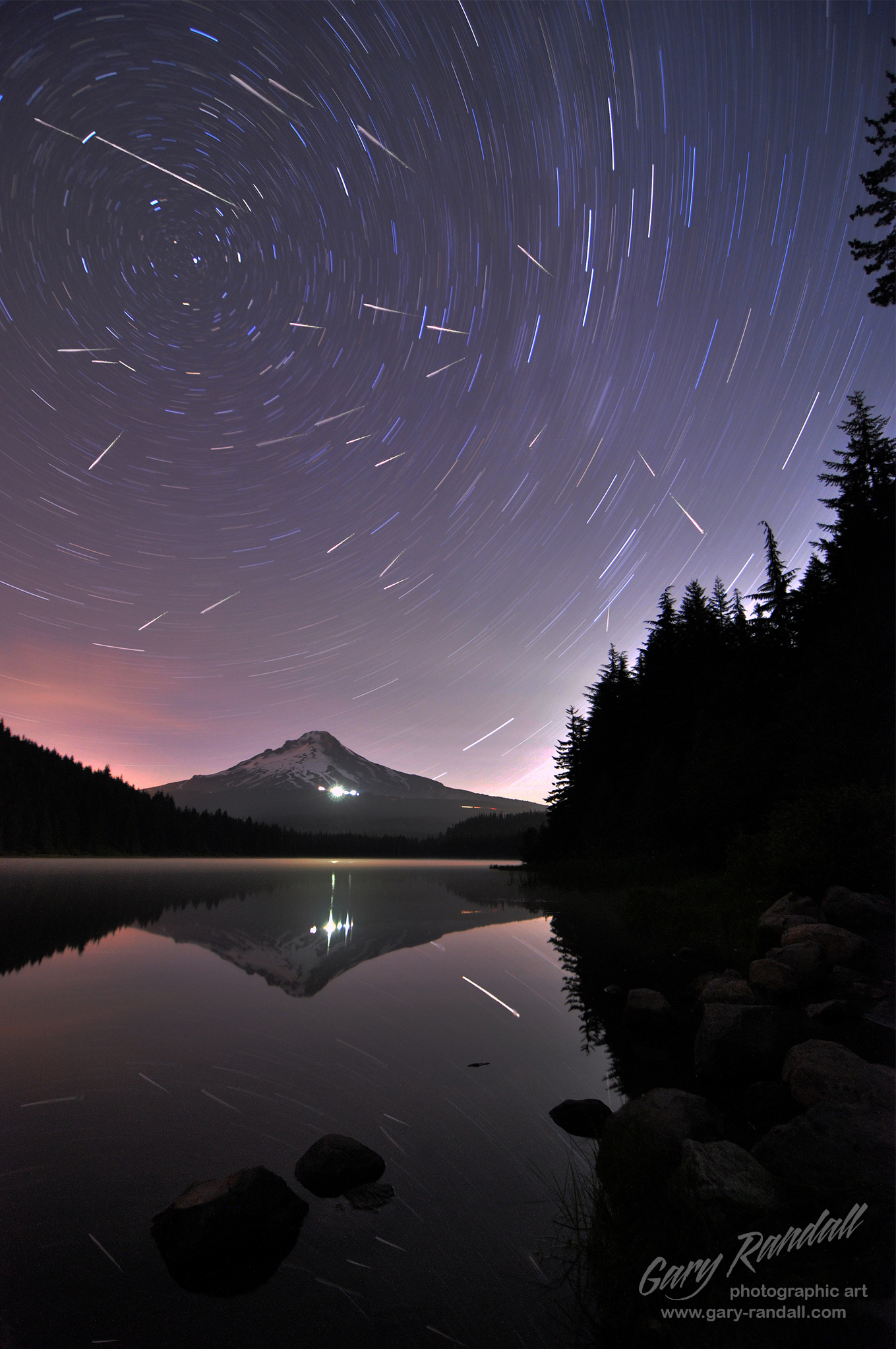This is a composite that took 360 images taken as 30 second exposures over a three hours period of time layered over a single 30 minute exposure.
The secret to this shot was to be patient for three hours as the camera snapped away its 30 second exposures first, and then in post processing the additional patience to sort through the 350+ images to separate the frames that held a meteor, and then to mask out all but the meteor in the shots prior to layering them onto the base image. But that wasn’t the end of the process. Once the meteors were layered over the base image I had to rotate them to align with their point of origin. Over the course of three hours the Earth rotates and so the point of origin changes. To correct for this I had to use Polaris as a pivot point and then to compute the time in relationship to the position and then rotate the meteor to correspond with that position. In all there is over 8 hours of time spent to create this image.
The point of origin is close to the position of the galaxy Cassiopeia and Perseus, thus the name of the meteor shower. When you go out to get your meteor shot make sure that you have a clear view to the northeastern sky that’s not affected by the lights from a city. The meteor shower will be the most intense during their peak August 11-12 after midnight. It is estimated that we could expect up to 200 or more meteors per hour this year, but one never knows until it happens.
To get your photo set up your tripod and mount your camera. Use a programmable shutter release and set it to take 30 second exposures one after another. This will allow you to be able to capture every meteor that will fall within the frame of your camera in that three hour period of time. Don’t move it while you’re getting your shots. You want all of your frames to be the same. I chose to shoot for three hours but you can shoot as long as the sky is dark and your battery and memory lasts.
Remember when you are shooting 30 second exposures that you will need to open your aperture and raise your ISO to allow you to expose the night sky. When shooting the 30 minute exposure you will be lowering your ISO and stopping down to about 5.6 or so. It all varies on how much ambient light in the sky.
Once you return home you will need to use Photoshop to allow you to import the photos with the meteors in as layers, and mask out all but the meteor. Sometimes changing the blend mode will help to blend them more naturally over the base image. For the base image choose one of your best ones for static stars or create a single star trail photo for a different effect, like I did with this one. Once they are all masked and layered over, locate the pivot to the center of the rotation of the Earth which is Polaris. Rotate the layer until it is moving away from the northeast sky and the Perseus galaxy. I used a formula that allowed me to determine how many degrees that it had moved in the time that it was taken and move it roughly that many degrees. If that’s all just a little too much, just layer them and call it good. It will give you a chaotic display as if they are coming from all points of the sky, but it’s still very cool.
I hope that this helps. Even if you don’t get a photo it’s such an amazing experience to be able to go out into the night and stare at the sky and count falling stars.
Thank you for your support and thoughtful comments.


Great shot Gary!
I’ve not yet accomplished a night photo but will try soon.
I had a thought about your photo and how it would look without the star trails. Just a still of the thousands of stars with the meteor trails going through them. You’ve probably done such a shot and found this one better.
Keep up the great work. You’ve inspired me to get a better camera and take up photography a second time!
Bruce Allert
Hi Bruce. Yes I have. I have shot the Perseids like this a couple times now.
The best part of this is that you can choose what base image to use. You can make both if you cared to with this composite.
Thank you Bruce.
Great info Gary! THANK you for sharing this with us. I plan on using 2 cameras plus a GoPro. I have been successful in the past with meteor showers and I do hope that the “200” comes true! I still owe you that beer(s)!
Toby!! Let’s get around to that beer my friend. 🙂 Good luck and please let me know how you do.
Hi, Gary!
I have a week trip planned in September to Yellowstone and the Grand Tetons…
Going to try my hand at some night work with my little Olympus mirrorless with a 12mm F2.0 and hope for the best…It will be my first try.
Wish me luck!
Hey Gary! You’re going to be in epic landscape photography areas. Your Olympus and your f/2.0 wide angle sound like the perfect combination for night skies. 🙂